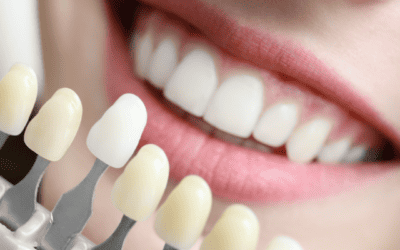Some of us may be feeling a bit guilty or a bit sluggish after the festive break and having overindulged over the holidays on sweet treats. The New Year may have brough on a resolution for healthier eating to improve our overall health, but what about our dental health? Healthy eating is so important and should be an everyday habit and a lifelong commitment. Read on for some diet help in relation to your teeth, why some foods are better for our teeth than others. Read to the end for one of Mishari’s low sugar recipes.
This blog is about sugar. If you want to know more about acid erosion, read our other blog here.
Why is sugar bad for our teeth?

Many of us know that sugar is bad for our teeth, but why? There are specific bacteria in the mouth that cause tooth decay and gum disease. The more of these bacteria we have, the more disease we can potentially have. And what causes more of these bacteria? Their food source – sugar!
Bacteria love sugar. They metabolise sugar and produce acids as waste products. These acids essentially start breaking down the tooth. This is what we call tooth decay. The more the bacteria feast on sugar, the more they will multiply. They leave a nice sticky film on your teeth that we call plaque. That furry feeling you get after having a sugar feast? That’s a nice thick layer of plaque – full of bacteria and their waste products. This plaque will cause tooth decay and gum disease.
When tooth decay begins, it’s the surface structure of the enamel that changes. As it progresses through the enamel, it reaches the inner, softer part of the tooth called dentine. Once the dentine has broken down significantly, it can’t support the enamel anymore and the enamel breaks away – this causes a hole in the tooth. As you can tell, the decay process is ongoing for some time before you would even notice a hole. Therefore, it’s so important to get regular check-ups. Decay is easier to treat and leads to less complications when it is small.
So how can we deal with all this plaque?
- Reduce how much plaque forms by reducing your sugar (cut those pesky bacteria off at the source!)
- Remove the plaque thoroughly through effective tooth brushing and flossing.
What is Sugar?
- Sugar is a form of carbohydrate that the body converts to glucose.
- There are several different sugars. Sugars occur naturally in some foods, such as fruit and dairy products, and are also added to a wide variety of foods. Sugar can take many different forms, including white, raw, or brown sugar, honey, or corn syrup.
- Sugars are popular in the processed food industry because they add taste, colour, bulk, and provide thickness to food products.
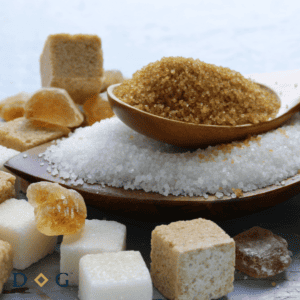
What does sugar do to our mouth?
- Sugar and tooth decay are closely linked. Dental plaque is a clingy film made up of food particles, bacteria and mucous. The bacteria in plaque depend on sugars to produce acids, which break down the enamel and start tooth decay.
- All carbohydrates contribute to this process.
- The worst offenders are sticky sugars (e.g. dried fruits) and sugars in sweets and soft drinks.
- Even nutritious foods e.g. fruits and dried fruits, can allow bacteria in plaque to produce acids.
What does sugar do to the body?
According to the World Health Organisation, poor diet and physical inactivity are some of the most common causes of non-communicable diseases (NCD). A NCD is one that is not transmissible from one person to another and includes tooth decay (along with heart disease, most cancers, diabetes etc.,). A high level of free sugars intake is a concern as it’s associated with a poor quality of diet, obesity, and an increased risk of a non communicable disease.
Dental decay is actually the most prevalent non-communicable disease across the world. Tooth decay causes pain, a limit in function (including time off work and school) and the social and mental implications of tooth loss or being self-conscious about your smile. The WHO also states that although exposure to fluoride reduces dental decay and delays the onset of cavities forming, it does not completely prevent it. This just shows how important diet is. You can brush and floss and do all the prevention you can, but if you are still consuming a lot of sugar, you will still get decay.
What other damage can sugar do?

Studies have shown association between a high-sugar diet and a greater risk of dying from heart disease. One study, published in the JAMA Internal Medicine in 2014 found that those who got 21% of their calories from added sugar had a 38% greater risk of dying from heart disease than those who only consumed 8% of their calories from sugar.
In addition, your liver metabolises sugar much like it does alcohol. It converts sugar to fat. Over time this can lead to fatty liver disease. This can contribute to diabetes and increase your risk for heart disease. Too much sugar can also increase blood pressure and chronic inflammation. Both can lead to heart disease and stroke.
What are the different types of sugar?
The term “sugars” includes intrinsic sugars, which are those incorporated within the structure of the cells of intact fruit and vegetables. Conversely, extrinsic sugars, are those outside the structure of cells. Extrinsic sugars include sugar which is added to food as well as those sugars which have been extracted from the cells, as in the case of juiced fruit.
Natural Sugars
Natural sugars pose little problems to the teeth provided they are within their original intact form e.g., whole fruit. However, these sugars become damaging for teeth when they are concentrated, in the form of dried fruit, fruit juice, honey or pure sugar. For example, eating an apple is much less damaging for your teeth than drinking apple juice or eating dried apple.
Free Sugars
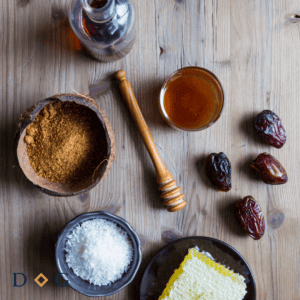
Free sugars, are those which are added to foods and beverages by the manufacturer, cook or consumer – you may also hear these being called ‘added sugars’. However, free sugars also include those naturally present in honey, syrups, fruit juices and fruit juice concentrates. It’s the free sugars that cause problems with your teeth and your general health. These free sugars are the ones added into your ketchup, bread, yoghurt, cereal and even baked beans. Compare this amount per 100 grams to other similar products to see which is the lowest sugar version (you can also do this to check salt content).
Hidden Sugars
Sadly, many food products have sugar in them. Food manufacturers hide sugars in a lot of our food where we don’t expect it. Sugar is even a prominent ingredient in bacon and is most notorious for being in anything labelled ‘fat free’. Sugar can pop up in the most unlikely of places. It is especially sneaky when they hide in things that you may perceive as healthy, for example muesli, low fat yogurts and wholemeal bread.
When doing your weekly shop, we encourage you to have a look at the ingredients and sugar content of your favourite supermarket produce. The easiest way to compare products is to look at the ‘per 100g’ column. For example, below we can compare the same yoghurt brand. One is plain yoghurt, one is labelled ‘fat free’:
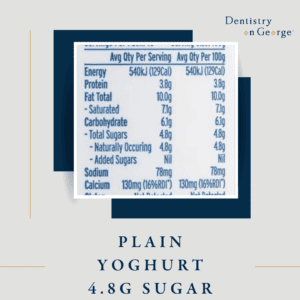
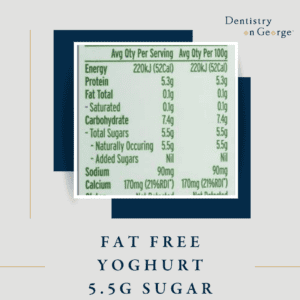
This may not seem like a big difference, but if on having an ‘average serving’, you would have an extra 0.7g of sugar if you chose the fat free version. Bearing in mind that the the WHO recommends we reduce our sugar to 25 grams of sugar per day, it can quickly add up. Now let’s look at the same yoghurt again, but a vanilla flavoured version:
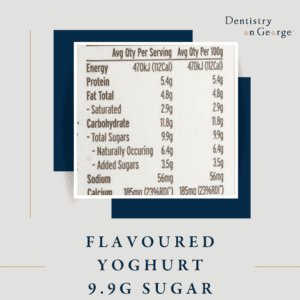
This one’s got a whopping 9.9g of sugar per 100g. That’s over double the amount of sugar as the original full fat version. If you are aiming for 25g of sugar per day, one serving of yoghurt leaves you with only 15.1g of sugar for the rest of the day. Therefore, a simple switch from a flavoured yoghurt to a plain full fat version can reduce your sugar intake by more than a half. The taste can take a bit of getting used to! Our suggestion is to put some fresh fruit in the yoghurt and start with a little drizzle of honey. Remember, honey is still sugar and will still cause decay, but much like reducing the sugar in your tea and coffee, you can slowly reduce it over time as your taste buds adapt.
Why is snacking bad for your teeth?
Plaque bacteria love sugar. When you eat sugar, these bacteria feed off it, producing acid. This acid causes tooth decay – the teeth start to rot and cavities form. This can be caused by eating sugar, or even eating something that breaks down into sugar (carbohydrates, like bread). Every time you snack, your teeth go under this ‘acid attack’. It can take up to 20 minutes for your saliva to neutralise these acids. If you keep snacking, your saliva will struggle to neutralise the acids – every time your mouth has almost gone back to normal, you have another square of chocolate, biscuit or a sip of a sugary drink, and the cycle begins all over again.
Therefore, after reducing the amount of sugar in your diet, the second thing to consider in keeping a healthy mouth is to reduce the frequency of sugars.


Healthy Snacks
Swap out chocolates, biscuits, and other sugary snacks for these alternatives:
- Cheese on crackers (check the sugar content of the crackers)
- Veggies (carrots, cucumber, capsicum) dipped in hummus
- Nuts
- Fresh fruit
- Peanut butter on crackers or toast (make sure you go for natural peanut butter made from 100% peanuts – no added salt or sugar).
- Boiled egg
Mishari’s Low Sugar Banana Bread
Ingredients:
- 1/3 cup light olive oil
- 1/4 cup organic honey or rice malt syrup
- 2 large free range eggs
- 3 medium ripe bananas, mashed
- 1/4 cup lactose free ( skimmed ) milk
- 1 tsp vanilla extract
- 1 cup wholemeal flour or similar
- 1tsp baking soda
- 1/2 tsp salt
- 1/2 tsp cinnamon
- 1/2 cup chopped walnuts
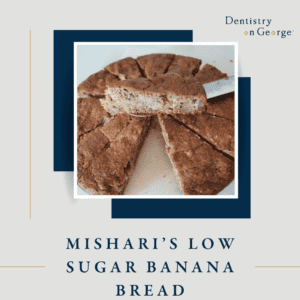
Method
- Preheat oven to around 165 degrees (fan assisted)
- Medium bowl – mix oil and honey. Then eggs, whisk , then mashed bananas milk, vanilla and combine.
- In big bowl mix the dry ingredients – then add the wet ingredients to the dry and mix well until it’s the consistency of a sticky batter.
- Pour batter into greased baking tin.
- Bake for around 55 minutes.
Recap: How to reduce the risk of decay
- Brush and floss regularly – twice a day for brushing and at least once a day for flossing
- Cut down on sticky, sugary, and processed carbohydrates like lollies and processed foods
- Use fluoride containing toothpaste
- Leave at least 2 hours between meals
- Drink water instead of cordials, soft drinks, and juices
- Visit your dentist regularly

What to do if I have already damaged my teeth?
If you are worried about tooth decay or your diet, please speak to your dentist. Prevention is always better than cure, and here at Dentistry On George, we take pride in giving honest advice and helping you care for your teeth at home. Read about what’s included in our New Patient Comprehensive Examination here.

